Criticism
"The Metamorph" and The Metamorphoses
Art and Story No 2 (August 1976) p24-27
Art & Story was a science fiction fanzine by James D. Denney.
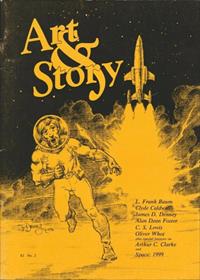
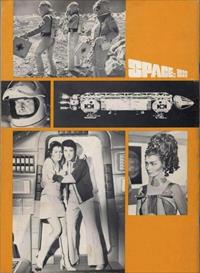
By JAMES D. DENNEY
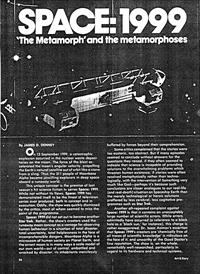
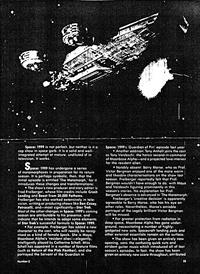

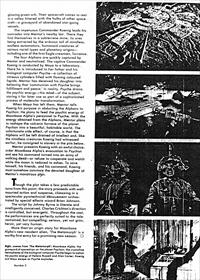
[Although mostly feeding off Year 2 publicity materials, this is a rare positive review of Space: 1999. Thanks to Jenny Lobb]
13 September 1999, a catastrophic explosion occurred in the nuclear waste depositories on the moon. The force of the blast accelerated the moon's angular velocity, propelling the Earth's natural satellite out of orbit like a stone from a sling. Thus the 311 people of Moonbase Alpha became unwilling explorers in deep space aboard a runaway world.
This unique concept is the premise of last season's hit science fiction tv series Space: 1999. While not without its flaws, Space: 1999 has demonstrated itself to be the finest Sf television series ever produced, both in concept and in execution. Oddly, the show was quickly dismissed by the critics, most of whom seemed to miss the point of the programme.
Space: 1999 did not set out to become another Star Trek. Rather, the show's creators used the runaway moon concept as a vantage for observing human behaviour in a situation of total disaster, total uncertainty, total helplessness in the face of incomprehensible dangers. Moonbase Alpha is a microcosm of human society on Planet Earth, and the errant moon is in many ways a scale model of our own world-out of control, embattled and wracked by disaster, its inhabitants mercilessly buffeted by forces beyond their comprehension. Some critics complained that the stories were too esoteric, too abstract. But if many episodes seemed to conclude without answers for the questions they raised, if they often seemed to indicate that science is incapable of providing solutions to the overwhelming problems which threaten human existence, if stories were often resolved metaphysically rather than technologically, with the intervention of Something very much like God-- perhaps it's because such conclusions are closer analogues to our real-life (and real-death) situation on Spaceship Earth than the merely technological or heroic solutions proffered by less cerebral, less cogitative programmes such as Star Trek.
Another oft-repeated complaint against Space: 1999 is that it contains an unacceptably large number of scientific errors. While errors admittedly have occurred (a reference to a black hole as a 'black sun,' for instance), this charge is rather exaggerated; Dr. Isaac Asimov's assertion that Space: 1999's creators are 'chemically free of all traces of scientific knowledge' is ridiculous on the face of it, and unworthy of the Good Doctor's fine reputation. The show is, on the whole, remarkably well-researched, particularly in regard to its hardware and technical systems.
Space: 1999 is not perfect, but neither is it a cop show in space garb. It is a solid and well-integrated attempt at mature, undiluted Sf in television. It works.
Space: 1999 has undergone a series of metamorphoses in preparation for its return season. It is perhaps symbolic, then, that the initial episode is entitled 'The Metamorph,' for it introduces these changes and transformations:
As 'The Metamorph' opens, it is 342 days since the lunar breakaway from Earth. The Alphans desperately need titanium to repair a life-support system severely damaged during a violent 'space-warp' displacement, so an Eagle spacecraft is dispatched to reconnoitre an approaching planet for environmental suitability and mineral composition. The Eagle pilots' scan reveals that though the planet is seething with volcanic activity and seemingly uninhabitable, it does possess the badly needed titanium.
On attempting to return to base, however, the Eagle is pursued and engulfed by a ball of green light, which returns ship and crew to the planetary surface. The planet is inhabited after all: called Psychon, it is indwelt by a crafty alien scientist, Mentor, and his beautiful daughter Maya. Unlike her treacherous father, Maya is the very picture of wide-eyed trusting naivete; like him, she possesses certain techniques for the transformation of matter into diverse forms, so that she appears variously as a lion, a dog, or a dove as the occasion warrants.
John Koenig, accompanied aboard a second Eagle by Dr. Russell, Alan Carter (Nick Tate), and another Alphan crewman, is lured into space by Mentor's promise to return the captive pilots. Once in space, they too are captured by Mentor's glowing green orb. Their spacecraft comes to rest in a valley littered with the hulks of other spacecraft-a graveyard of abandoned star-going vessels.
The impetuous Commander Koenig leads his comrades into Mentor's nearby lair. There they find themselves in a subterrene mine, its ores being extracted by the arduous toil of mindless, soulless automatons, humanoid creatures of various racial types and planetary origins-including one of the first Eagle crewmen, Torrance [Torens].
The four Alphans are quickly captured by Mentor and neutralised. The captive Commander Koenig is conducted by Maya to a laboratory. There he is introduced to her father and his biological computer Psyche, a collection of vitreous cylinders filled with flowing coloured liquids. Mentor has deceived his daughter into believing that 'communion with Psyche brings fulfilment and peace"; in reality, Psyche drains the psychic energy-the mind-of the subject, storing it for later use as part of a sophisticated process of molecular transformation.
When Maya has left them, Mentor tells Koenig his purpose in abducting the Alphans to Psychon: He plans to feed the psychic energy of Moonbase Alpha's personnel to Psyche. With the energy obtained from the Alphans, Mentor plans to reshape the volcanic furnace of the planet Psychon into a beautiful, habitable world. The unfortunate side effect, of course, is that the Alphans will be left drained of intellect and, like the mindless creatures Koenig had witnessed earlier, be consigned to slavery in the pits below.
Mentor presents Koenig with an awful choice: order Moonbase Alpha's evacuation to Psychon and see his command turned into an army of walking dead-or refuse to cooperate and watch while the moon is reduced to ashes. To save himself, his friends, and his command, Koenig must somehow convince the devoted daughter of Mentor's monstrous plan.
Though the plot takes a few predictable turns from this point, the story proceeds with well-mounted action and suspense, climaxing in a spectacular pyrotechnical denouement orchestrated by special effects wizard Brian Johnson.
The script by Johnny Byrne is literate and intelligently conceived. Charles Crichton's direction is controlled, but energetic. Throughout the cast, the performances are perfectly suited to the tale: restrained, but compelling; serious, yet not grim; heroic, yet very human.
More than an origin story for Moonbase Alpha's new resident alien, 'The Metamorph' is a worthy first entry for a promising new season.